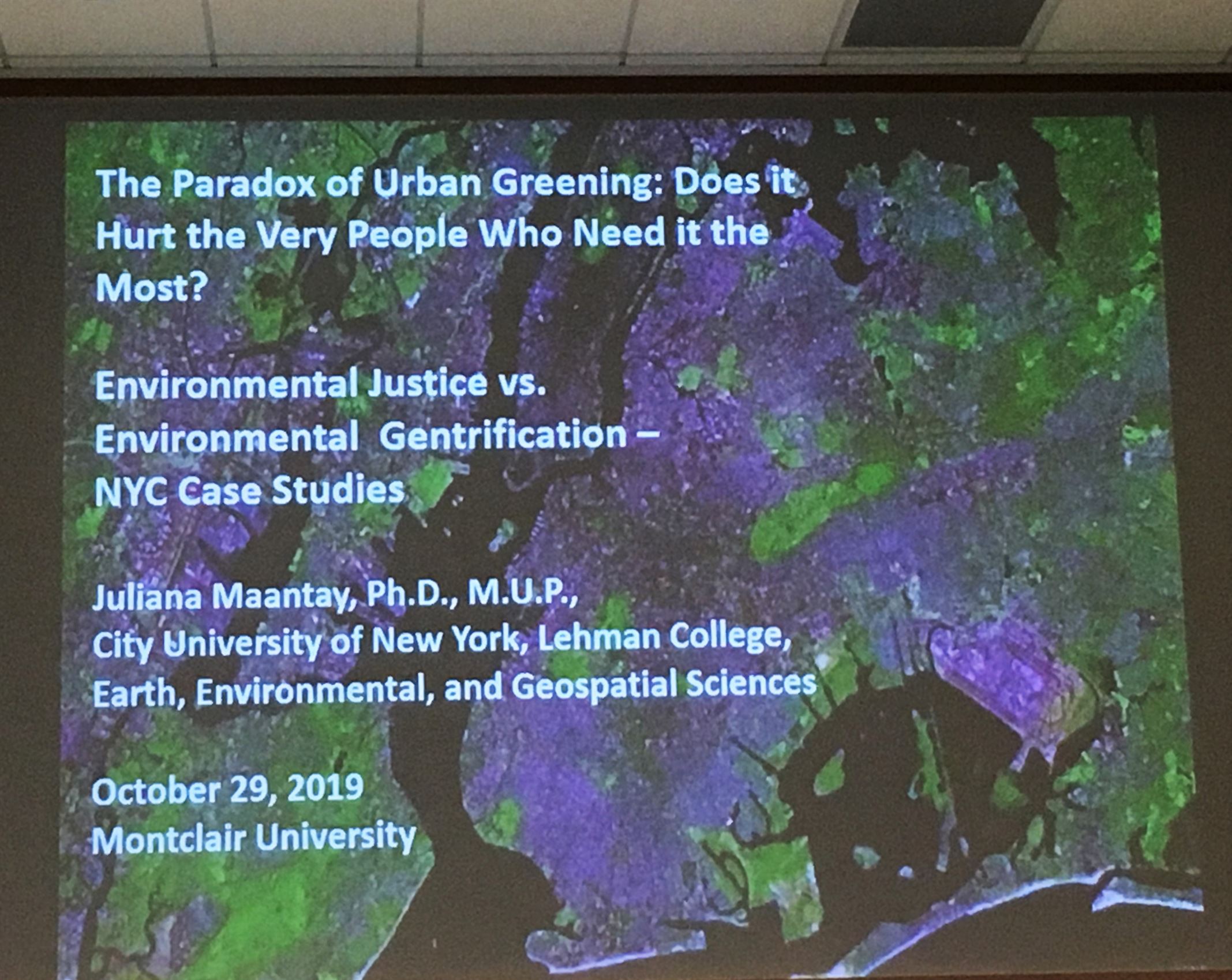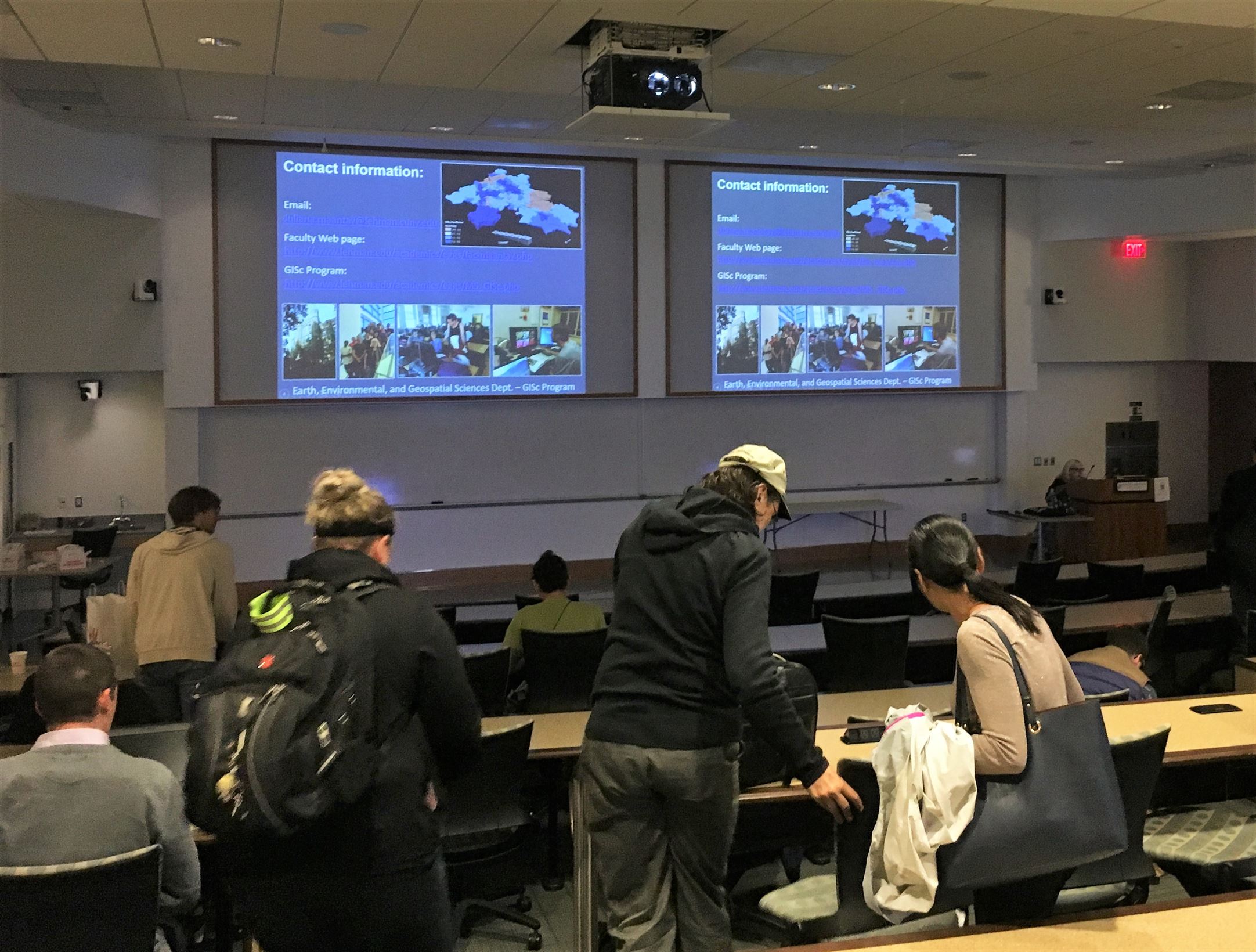Montclair State University students flooded the Center for Environmental and Life Sciences (CELS) to attend the seminar, “The Paradox of Urban Greening: Does it Harm the Very People Who Need it the Most?” on Oct. 29.
The event was one out of 12 seminars in the sustainability seminar series held throughout the fall 2019 semester. It is organized by the doctoral program in Environmental Science and Management. The seminars are every Tuesday from 4 p.m. to 5 p.m. in CELS, room 120.
Jessica Miller, assistant professor in the Earth and Environmental Studies Department, invited Dr. Juliana Maantay, a professor of Urban Environmental Geography at City University of New York (CUNY) since 1998, to speak at the seminar.
“We often split up who we decide to ask based on people’s interest,” Miller said. “I asked Juliana Maantay [to speak], because she has been a mentor of mine for a long time since I started [at] the CUNY graduate center in 2007. She does a lot of work revolving environmental justice and that’s always been our common theme.”
Dr. Maantay introduced attendees to her talk with a brief impression of her research.
“Everybody probably agrees that urban greening is a good thing, in general, but what we have to also acknowledge is that there are unintended consequences that impact some populations more than others,” Maantay said.

“The Paradox of Urban Greening: Does it Hurt the Very People Who Need it the Most?” was part of the sustainability seminar series which is organized by the PhD program in Environmental Science and Management.
Kelvin Jimenez Michaca | The Montclarion
Maantay presented the audience with questions she details in her research.
“What is the relationship between urban greening and green gentrification? What are the implications of green gentrification for environmental justice? And then, who benefits from sustainable and beautiful green cities?”
A course in environmental sociology brought Daniela Antunez, senior English major, and Adriana Antunez, senior family science human development major, to the event.
“Our class meets once a week, so most of the time we do come to an event and write a reflection on the event as an assignment,” Daniela Antunez said.
Adriana Antunez shared the things she would consider in her reflection assignment.
“I’m going to reflect on gentrification, who does applying gardens into urban areas actually benefit? Does it benefit the minorities in that community? Are they [minorities] the ones actually helping with the garden? Or is it just non-Hispanic white people benefiting from it?” Adriana Antunez said.
Daniela Antunez made connections from the seminar with her experiences growing up in Morristown, New Jersey. She believes Morristown is subject to the impacts of gentrification and urban greening.
She mentioned, “The Green” which is located in the center of Morristown, where she has seen an increase in business development in a predominantly low-to-middle income housing section.
“Towns need change and they need to progress so they can get different people to come to the town, but I don’t think it’s okay to kick out people who have lived in these areas their whole life,” Antunez said. “Eventually, these people won’t be able to afford to live in Morristown.”
Ruthi Nguyentran, senior nutrition and food science major, recommended what local environmentalists should consider when discussing greening efforts.
“Every time you look at a system, it’s so easy to have a solution to one particular problem, but you don’t understand how it effects the whole system,” Nguyentran said.
She explained further the impact of making important decisions when it comes to greening efforts.
“I think it’s really important to look at other cities that are similar to the demographic and geography to Montclair and look up what they’ve done, the steps they’ve taken, whether or not they were successful and whether or not we can actually implement what they did to Montclair,” Nguyentran said.
Nguyentran, who is a former president to the Environmental Club, is aware of the ways in which the Montclair State community is embracing urban greening and sustainability efforts.
“Chartwell’s is switching out for paper straws. I also believe that they are in the process of eliminating water bottles and distributing them, they are trying to encourage students to use the hydration stations,” Nguyentran said.
She also mentioned the community garden on campus, as an example of urban greening on campus.
“Within that community garden, they just recently got a composter,” Nguyentran said. “They are going to be teaching students how to compost and collect some [compost] from campus.”
According to montclair.edu, The Montclair State University Campus Community Garden (MSUCCG) was founded in 2018 as the first community garden on campus. Montclair State reclaimed and revitalized underutilized space on the campus, and have established 20 raised garden beds, totaling 1,000 square feet of growing space, that is opened up to the community members each year.
Naomi Zaldivar, junior psychology and animation and illustration major, is president of the Environmental Club on campus.
“A lot of students aren’t aware that Montclair State is pushing toward more environmentally friendly and sustainable sources and resources,” Zaldivar said. “The big one is with [Montclair State’s] recycling, there is an entire section on the university website.”
Zaldivar mentioned the reasons she believes students on campus are not aware of Montclair State’s green initiatives.
“There’s a lot of information that is available [provided by Montclair State], it’s just not being publicized and a lot of students don’t have time. Their main focus is their courses and not failing them,” Zaldivar said.
Zaldivar encourages students to check their emails, read the newspaper and attend the environmental club to become aware of environmental and sustainability practices, or events on campus.
“There are so many commuter students, so whatever information they learn about being environmentally friendly and sustainable, they can take back to their homes and start implementing there,” Zaldivar said. “We have students from so many different counties and that starts a conversation in all parts of New Jersey.”



